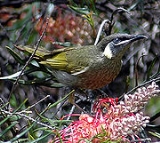
Lewin's Honeyeater
Encyclopedia
The Lewin's Honeyeater, Meliphaga lewinii, is a bird that inhabits the ranges along the east coast of Australia
. It has a semicircular ear patch, pale yellow in colour.
The name of this bird commemorates the Australian artist John Lewin
.
(fleshy corners of the mouth). It has large, yellowish crescent-shaped ear patches, which identify it from other honeyeaters other than similar but smaller species in tropical Queensland. In flight, the pale yellow edges of the flight feathers can be seen. The bill is black and the eye is blue-grey. Both sexes are similar in appearance. Young Lewin's Honeyeaters are similar to the adults, but have brown eyes. The strong 'machine gun' like rattling notes of Lewin's Honeyeater are heard over long distances and reveals its presence in an area.
Size, voice, and the shape and size of the ear patch distinguish similar species found in tropical Queensland.
Lewin's Honeyeaters breed during September to January. The nest is a large cup of vegetation and other materials, bound together with spider web and lined with soft material. The two to three oval eggs are incubated for about 14 days and the young birds leave the nest after a further 14 days. It is unclear what roles each parent performs in nest building and incubation, but both care for the young birds.
Australia
Australia , officially the Commonwealth of Australia, is a country in the Southern Hemisphere comprising the mainland of the Australian continent, the island of Tasmania, and numerous smaller islands in the Indian and Pacific Oceans. It is the world's sixth-largest country by total area...
. It has a semicircular ear patch, pale yellow in colour.
The name of this bird commemorates the Australian artist John Lewin
John Lewin
John William Lewin was an English-born artist active in Australia from 1800. The first professional artist of the colony of New South Wales, he illustrated the earliest volumes of Australian natural history.-Early life:...
.
Description
The Lewin's Honeyeater is small to medium in size (20cm - 22cm). It is dark greenish grey in colour, with a creamy yellow gapeGape
In bird anatomy, the gape is the interior of the open mouth of a bird and the gape flange is the region where the two mandibles join together, at the base of the beak...
(fleshy corners of the mouth). It has large, yellowish crescent-shaped ear patches, which identify it from other honeyeaters other than similar but smaller species in tropical Queensland. In flight, the pale yellow edges of the flight feathers can be seen. The bill is black and the eye is blue-grey. Both sexes are similar in appearance. Young Lewin's Honeyeaters are similar to the adults, but have brown eyes. The strong 'machine gun' like rattling notes of Lewin's Honeyeater are heard over long distances and reveals its presence in an area.
Size, voice, and the shape and size of the ear patch distinguish similar species found in tropical Queensland.
Distribution and Habitat
The Lewin's Honeyeater prefers the wetter parts of eastern Australia, from northern Queensland to central Victoria. It is found in both rainforest and wet sclerophyll forest, and often wanders into more open woodland. It is a common bird, and its call is often heard in these areas. It is a rather sedentary species, tending to stay in the same area all year round, although some altitudinal migration to lower elevations in the cooler winter months.Food and Feeding
Lewin's Honeyeaters feed mostly on fruits, favouring berries and small fruits, but also eat insects and nectar. Birds are normally seen alone, but may form loose groups of up to 10 birds. They feed in the upper branches and on the trunks of trees. Some insects are caught in flight.Lewin's Honeyeaters breed during September to January. The nest is a large cup of vegetation and other materials, bound together with spider web and lined with soft material. The two to three oval eggs are incubated for about 14 days and the young birds leave the nest after a further 14 days. It is unclear what roles each parent performs in nest building and incubation, but both care for the young birds.

